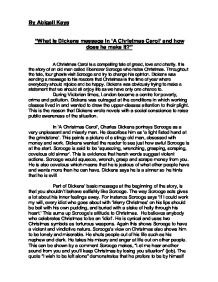The theme of this Christmas carol is poverty, and this article will discuss the role of the poor in the Christmas carol as well as the attitude of Scrooge towards it. We will also explore Tiny Tim’s plight and how poverty is portrayed in Dickens’ story. This article will not only help you understand the story, but also show a clear understanding of the Victorian era.
Scrooge’s attitude to poverty
For the purpose of this essay, I will analyse Scrooge’s attitude to poverty within A Christmas Carol. This Christmas classic was written by Charles Dickens, and it is one of the best-loved works of British literature. You can use key quotes to analyse Scrooge’s attitude to poverty in A Christmas Carol. For example, the Portly Gentlemen respond to Scrooge’s question about whether the poor should go to the workhouses. While Scrooge may be unaware of the fact that poor people are not idle, his attitude towards them is uncaring.
Scrooge’s first act is to refuse to attend Christmas dinner with his family. He views Christmas as a time to get richer and older, and he is not willing to make a charitable donation to the poor. However, Scrooge’s attitude toward poverty changes as the novel progresses. In the end, the author of A Christmas Carol reveals that Scrooge does care for Bob Cratchit.
After this rebuke, Scrooge returns to his old home to visit Bob Crachit. In his absence, he eats a skimpy Christmas dinner and finds a crippled boy named Tiny Tim. He sees two allegorical twins in the house that represent the ignorant and the desperate, but is unable to help them. This incident makes Scrooge start thinking more about the suffering people have in society, and he begins to feel compassion for them.
Tiny Tim’s plight
In A Christmas Carol, one of the characters, Tiny Tim, is crippled and ultimately dies. The Ghost of Christmas Yet to Come, a character that Scrooge has a deep resemblance to, foreshadows the death of Tiny Tim to Scrooge. If he doesn’t take action to make things better for Tiny Tim, he will certainly die.
The Tiny character in A Christmas Carol evokes emotions in the reader. Because the story is based on Dickens’s personal experiences, it appeals to the reader’s emotional intelligence. The character is not only a symbol of hope and renewal, but it is also a social commentary. This piece of literature focuses on the struggles of the poor and the suffering they experience.
Throughout the story, the reader is continually teased with the absence of sunlight. For example, the story begins with a foggy afternoon. Then, as the reader continues, they are teased with scenes of coal mines and other places where the sun cannot reach. The reader’s desire for sunshine is tantalizing throughout A Christmas Carol, as the author’s characters are in a constant state of despair and hopelessness.
The children of the poor need our help, but their situation is often far from perfect. Despite his disadvantaged position, Tiny Tim is an angel and the child of all of us. We can’t simply rely on a benign poltergeist to scare the plutocrats into action. Instead, we must work to create robust social welfare programs backed by progressive taxation to ensure that poor people can access the essential health care resources that they need.
Dickens’ portrayal of poverty
This Christmas carol essay will explore Dickens’ portrayal of poverty in the novella, A Christmas Carol. Dickens was born into poverty and grew up working in a workhouse. Dickens wanted to depict Christmas as a time of joy and no grief, and he used two wretched children to illustrate this. Dickens did not want to give the poor money, so he made them into characters – Ignorance and Want – in his novella.
In the novella, Dickens shows the contrast between the rich and the poor. In Stave One, Scrooge only cares about money, and he is unkind to his worker, Bob Cratchit. Dickens also blames rich businessmen for the poverty in the novella, and his ghost is filled with symbols of money and guilt. Despite the storyline and themes of poverty, it is not an easy read, but this essay will shed light on Dickens’ portrayal of poverty in the novella.
In the novel, Dickens presents the children as monsters. In one scene, the Ghost refers to the children as “monsters,” naming them as ignorance, want, and poverty. By contrast, this character’s situation is so horrific that even Scrooge is horrified. This depiction of poverty highlights how much inequality there is between wealthy and poor people.

